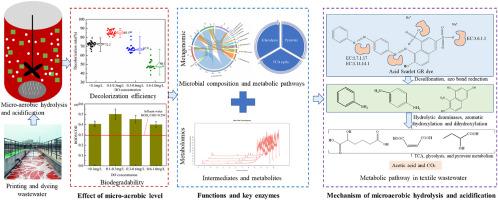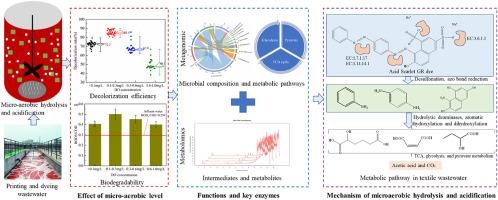纺织废水水解和酸化过程中微氧调控微生物脱色和代谢途径的多组学研究
IF 10
1区 环境科学与生态学
Q1 ENGINEERING, ENVIRONMENTAL
引用次数: 0
摘要
微氧水解酸化(MAHA)是一种很有前途的纺织废水预处理技术,但其微生物代谢机制尚不清楚。为了解决这个问题,宏基因组分析结合KEGG和MetaCyc数据库,对水解和酸化(HA)微生物的功能组成、代谢途径和关键酶活性进行了表征。结合代谢组学分析,提出了一种创新的酸性大红GR染料MAHA降解途径,为全面了解MA条件下的微生物代谢机制提供了依据。结果表明,在MA (0.1 ~ 0.3 mg/L)条件下,HA菌有选择性地富集,包括Brooklawnia(17.4%)、Bacillus(2.8%)、Paenirhodobacter(16.8%)和Pinisolibacter(1.4%),关键酶(EC:1.2.4.1, EC:2.8.3.1, EC:3.5.1)显著上调。, EC:1.14.13.)参与染料降解。结果表明,该系统的平均脱色效率为85.5%,BOD5/COD比为0.50,COD去除率为29.7%,乙酸产量为107.5±8.7 mg/L。功能注释揭示了与发酵、糖酵解、丙酮酸代谢和三羧酸(TCA)循环相关的活性微生物途径。代谢组学分析鉴定了酸红GR降解的16个中间体,揭示了一条包括偶氮键还原、脱硫、水解脱胺和芳香环裂解的途径,最终进入中心碳代谢产生乙酸和二氧化碳。这项工作通过将微生物群落结构、酶活性和代谢物通量联系起来,提供了新的机制见解,突出了提高HA性能的特定微生物和酶驱动因素。这些发现促进了对MAHA工艺的理解,并支持其在纺织废水处理中的优化应用。在MA (0.1-0.3 mg/L)条件下,HA细菌有选择地富集,包括Brooklawnia(17.4%)、芽孢杆菌(2.8%)、Paenirhodobacter(16.8%)和Pinisolibacter(1.4%),关键酶(EC:1.2.4.1, EC:2.8.3.1, EC:3.5.1)显著上调。, EC:1.14.13.)参与染料降解。结果表明,该系统的平均脱色效率为85.5%,BOD5/COD比为0.50,COD去除率为29.7%,乙酸产量为107.5±8.7 mg/L。功能注释揭示了与发酵、糖酵解、丙酮酸代谢和三羧酸(TCA)循环相关的活性微生物途径。代谢组学分析鉴定了酸红GR降解的16个中间体,揭示了一条包括偶氮键还原、脱硫、水解脱胺和芳香环裂解的途径,最终进入中心碳代谢产生乙酸和二氧化碳。这项工作通过将微生物群落结构、酶活性和代谢物通量联系起来,提供了新的机制见解,突出了提高HA性能的特定微生物和酶驱动因素。这些发现促进了对MAHA工艺的理解,并支持其在纺织废水处理中的优化应用。本文章由计算机程序翻译,如有差异,请以英文原文为准。


Multi-omics insights into micro-oxygen-regulated microbial decolorization and metabolic pathways during hydrolysis and acidification of textile wastewater
Micro-aerobic hydrolysis and acidification (MAHA) is a promising pretreatment for textile wastewater, yet the microbial metabolic mechanisms underlying its efficiency remain unclear. To address this, metagenomic analyses, coupled with the KEGG and MetaCyc databases, were utilized to characterize the functional composition, metabolic pathways, and key enzyme activities of hydrolysis and acidification (HA) microorganisms. Integrating metabolomic profiling, an innovative MAHA degradation pathway for Acid Scarlet GR dye was proposed, offering a comprehensive understanding of the microbial metabolic mechanisms under MA conditions. The results showed that HA bacteria under MA conditions (0.1–0.3 mg/L) were selectively enriched, including Brooklawnia (17.4 %), Bacillus (2.8 %), Paenirhodobacter (16.8 %), and Pinisolibacter (1.4 %), alongside significant upregulation of key enzymes (such as EC:1.2.4.1, EC:2.8.3.1, EC:3.5.1., EC:1.14.13.) involved in dye degradation. Consequently, the system achieved an average decolorization efficiency of 85.5 %, BOD5/COD ratio of 0.50, COD removal of 29.7 %, and acetic acid production of 107.5 ± 8.7 mg/L. Functional annotation revealed active microbial pathways associated with fermentation, glycolysis, pyruvate metabolism, and the tricarboxylic acid (TCA) cycle. Metabolomic profiling identified 16 intermediates of Acid Scarlet GR degradation, revealing a pathway encompassing azo bond reduction, desulfonation, hydrolytic deamination, and aromatic ring cleavage, ultimately channeling into central carbon metabolism to generate acetic acid and CO2. This work provides novel mechanistic insights by linking microbial community structure, enzyme activity, and metabolite fluxes, highlighting the specific microbial and enzymatic drivers of enhanced HA performance. These findings advance the understanding of MAHA processes and support its optimized application for textile wastewater treatment.
HA bacteria under MA conditions (0.1–0.3 mg/L) were selectively enriched, including Brooklawnia (17.4 %), Bacillus (2.8 %), Paenirhodobacter (16.8 %), and Pinisolibacter (1.4 %), alongside significant upregulation of key enzymes (such as EC:1.2.4.1, EC:2.8.3.1, EC:3.5.1., EC:1.14.13.) involved in dye degradation. Consequently, the system achieved an average decolorization efficiency of 85.5 %, BOD5/COD ratio of 0.50, COD removal of 29.7 %, and acetic acid production of 107.5 ± 8.7 mg/L. Functional annotation revealed active microbial pathways associated with fermentation, glycolysis, pyruvate metabolism, and the tricarboxylic acid (TCA) cycle. Metabolomic profiling identified 16 intermediates of Acid Scarlet GR degradation, revealing a pathway encompassing azo bond reduction, desulfonation, hydrolytic deamination, and aromatic ring cleavage, ultimately channeling into central carbon metabolism to generate acetic acid and CO2. This work provides novel mechanistic insights by linking microbial community structure, enzyme activity, and metabolite fluxes, highlighting the specific microbial and enzymatic drivers of enhanced HA performance. These findings advance the understanding of MAHA processes and support its optimized application for textile wastewater treatment.
求助全文
通过发布文献求助,成功后即可免费获取论文全文。
去求助
来源期刊

Journal of Cleaner Production
环境科学-工程:环境
CiteScore
20.40
自引率
9.00%
发文量
4720
审稿时长
111 days
期刊介绍:
The Journal of Cleaner Production is an international, transdisciplinary journal that addresses and discusses theoretical and practical Cleaner Production, Environmental, and Sustainability issues. It aims to help societies become more sustainable by focusing on the concept of 'Cleaner Production', which aims at preventing waste production and increasing efficiencies in energy, water, resources, and human capital use. The journal serves as a platform for corporations, governments, education institutions, regions, and societies to engage in discussions and research related to Cleaner Production, environmental, and sustainability practices.
 求助内容:
求助内容: 应助结果提醒方式:
应助结果提醒方式:


